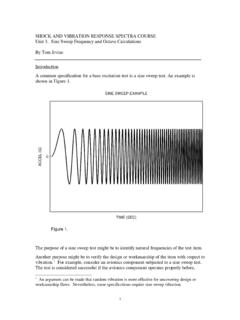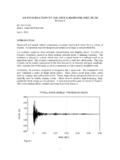Transcription of Response Spectra Objectives - Civil Engineering
1 Response a Response the uses of a Response the types of Response how to calculate a velocity and acceleration time history from adisplacement Response how to calculate a deterministic Response spectrum for a given earthquakemagnitude and source how to calculate a IBC 2000 1. Displacement Response spectrum for 2 percentdamping (after Chopra).1. DefinitionThe peak or maximum Response (acceleration, velocity, displacement) of all possible linear singledegree of freedom (SDF) system to a particular component of ground motion for a given level of the Response Response spectrum provided a convenient and practical way to summarize thefrequency content of a given acceleration, velocity or displacement time provides a practical way to apply the knowledge of structural dynamics to designof structures and development of lateral force requirements in building Spectra (5% Damping)Spectral Acceleration (g)Period (sec)
2 Time HistoryAcceleration (g)Time (sec) 2. Acceleration Response Spectrum for Yerba Buena 3. Acceleration Time History for Yerba Buena Island from the 1989 Loma of Response Spectra calculated from actual time historiesResponse Spectra (5% Damping)Spectral Displacement (ft)Period (sec) Spectra (5% Damping)Spectral Velocity (ft/sec)Period (sec) 4. Displacement Response Spectrum for the Yerba Buena 5. Velocity Response Spectrum for the Yerba Buena for calculating a Response spectrum from a time historyThe Response spectrum for a given ground motion component ( , a(t)) is developedusing the following steps:(1)Obtain the ground motion (a(t)) for an earthquake.
3 Typically the accelerationvalues should be defined at time steps of second, or less.(2)Select the natural vibration period, T, and damping ratio, , for SDOF system. n(Usually 5 percent damping is selected.)(3)Determine the maximum displacement Response for a SDOF structure with theselected percent damping for a given period or frequency of do this, you must solve the following differential equationmMu/dt + c Mu/dt + k u = F(t)22 This can be solved using (see Chopra, Ch. 1, pp. 28-32):(a)Closed form solution (linear systems) !Solution is only valid for initial conditions at rest (b)Duhamel s integral (linear systems)!
4 Based on treating the periodic motion as a series of shortimpulses(c)Frequency Domain method (linear systems)!Fourier transform!Inverse Fourier transform(d)Numerical methods (linear and nonlinear systems)!Numerical time stepping methods(4)Repeat step 3 and vary the fundamental period of the structure by changing the mass(m), the stiffness (k), or both. Plot the new of Using NONLIN to create a displacement Response spectrum First linear analysism = 100 kipsk = 100 kips / inc = 5 percent of critical dampingearthquake record is Imperial Valley El Centro Record ( )period = s, f = Hz, = rad/smax.
5 Displacement = inchesSecond linear analysism = 100 kipsk = 50 kips / inc = 5 percent of critical dampingearthquake record is Imperial Valley El Centro Record ( )period = s, f = Hz, = rad/smax. displacement = inchesThird linear analysism = 100 kipsk = 25 kips / inc = 5 percent of critical dampingearthquake record is Imperial Valley El Centro Record ( )period = s, f = Hz, = rad/smax. displacement = inchesExample of Using NONLIN to create a displacement Response spectrumFourth linear analysism = 100 kipsk = 200 kips / inc = 5 percent of critical dampingearthquake record is Imperial Valley El Centro Record ( )period = s, f = Hz, = rad/smax.
6 Displacement = inchesFifth linear analysism = 100 kipsk = 400 kips / inc = 5 percent of critical dampingearthquake record is Imperial Valley El Centro Record ( )period = s, f = Hz, = rad/smax. displacement = inchesSixth linear analysism = 100 kipsk = 1000 kips / inc = 5 percent of critical dampingearthquake record is Imperial Valley El Centro Record ( )period = s, f = Hz, = rad/smax. displacement = inchesDisplacement Response (s)Max. Displacement (in)Figure 6. Displacement Response Spectrum for El 7. Displacement Response Spectrum Response (s)Max. Pseudo Velocity (in/s)Figure 8.
7 Velocity Response Spectrum for 9. Velocity Response Spectrum from NONLIN(5)Calculate the other pseudospectral velocity values using:V = DAcceleration Response (s)Max. Pseudo Acceleration (g)Figure 10. Acceleration Response SpectrumFigure 11. Acceleration Response Spectrumfrom NONLIN(6)Calculate the pseudoacceleration Response values from:A = D2It is common to express A in units of g, thus:A(in g) = D/g2 Comparison Response (s)Spectral acceleration (g)Abrahamson and Silva (1997) Rock or Stiff SoilBoore, Joyner and Fumal (1997) Vs = 762 Spudich et al. (1999) RockFigure 12. Comparison of Deterministic Rock Spectra for M = , R = 5 km earthquake from attenuation Response Spectra from attenuation relations!
8 Deterministic spectrum are usually developed for the maximum credibleearthquake (MCE).!The maximum credible earthquake is the largest earthquake possible from theactive faults in the ContributionMagnitude (M)Distance (km)Deaggregated Seismic Hazard for PGA2500 return period year eventSalt Lake City, Utah (Source: USGS)pga = Hazard Spectra (Rock) for Salt Lake (s)Spectral Acceleration (g)10 % PE in 50 yr5 % PE in 50 yr2 % PE in 50 yrFigure 13. Seismic Hazard and Percent Contribution ofM and R pairs for 2500 year return period event (2percent probability of exceedance in 50 years) for peakground 14.
9 Probabilistic Uniform Hazard Spectra for inputzipcode 84115 for Spectra for Probabilistic Seismic Hazard Analysis (PSHA) Spectra Developed from Building Codes(See Lecture 6b).











